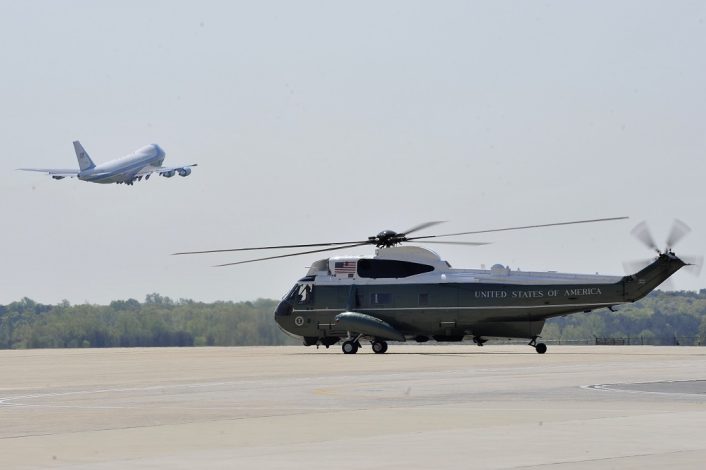Six VH-92As will be delivered to replace aging VH-3D and VH-60N helicopters.
Naval Air Systems Command (NAVAIR) on June 10, 2019, awarded Lockheed Martin a $ 542 million contract to build six VH-92A presidential helicopters. The new helicopters are part of the Low-Rate Initial Production (LRIP), with contract options for up to 23 total aircraft, that will replace the current fleet of 11 VH-3Ds and 8 VH-60Ns.
The Presidential VH-3D, (that, when carrying the President of the U.S. uses the radio callsign “Marine One” by which the aircraft is known) is operated by the U.S. Marine Corps HMX-1. The unit also operates the green-painted MV-22 Ospreys (also referred to as “Green Tops”) that fly the White House Staff during the President’s travels.
Both the “White Tops” (VH-3Ds and VH-60Ns), that usually fly the POTUS and accompanying VIPs at home and abroad as part of the Executive Flight Detachment, and the “Green Tops” (12x MV-22 Ospreys) that fly the supporting staff, are based at Quantico, Virginia, south of Washington DC.
The Executive Flight Detachment actually operates extensively out of an alert facility at Naval Support Facility Anacostia in Washington DC, much closer to the White House than Quantico.
According to NAVAIR’s official statement “the VH-92A aircraft will increase performance and payload over the current Presidential helicopters, VH-3D and VH-60N, that have been serving over 40 years. The VH-92A will provide enhanced crew coordination systems and communications capabilities, plus improve availability and maintainability.”
The helicopters follow the three VH-92As already acquired for testing, which have been regularly flying at NAS Patuxent River in various conditions for approximatively 520 flight hours, including take-off and landing on the White House South Lawn in 2018. Pilots from Marine Helicopter One Squadron (also known as HMX-1) are already training on the new helicopter, after Lockheed Martin delivered the first VH-92A training device at Marine Corps Base Quantico, in Virginia, earlier this year. The Flight Training Device (FTD) is a replica of the VH-92A cockpit to give pilots mission-oriented flight training in a simulation-based training device. The Initial Operational Capability is expected in late 2020, while the deliveries should be complete by 2023.

According to Vertical Magazine, “as of last May, total acquisition costs for the Sikorsky VH-92A presidential helicopter were estimated at $4.95 billion, down around 4.5 percent from the $5.18 billion estimated in April 2014. With the program expected to deliver 23 aircraft, that equates to a unit cost of around $215 million per helicopter.”
The U.S. Navy already attempted to replace its aging Marine One fleet when, in 2005, Lockheed Martin and AgustaWestland won the first VXX competition with a variant of the AW-101, called VH-71, against a first version of the Sikorsky VH-92. After years of delays and a cost increase from the initial $ 6.5 billion up to $ 13 billion, the program was terminated in 2009. According to Leonardo Aircraft Division, the new company into which AgustaWestland merged, the seven VH-71 prototypes already built are being converted in the CH-149 Cormorant configuration and they will integrate the current Search and Rescue fleet of 14 Cormorant helicopters in service in the Royal Canadian Air Force.
Based on Sikorsky’s commercial S-92, used primarily for offshore oil platforms and SAR operations, the VH-92A incorporates an executive cabin interior and specialized equipment for the U.S. President. Not much is known about this equipment, but it is believed that, as the VH-3D, it will include a day/night/all-weather operations navigation system, GPS, TCAS, survivability systems, extensive secure and non-secure communication systems, EMP hardening and ballistic armor. The only confirmed features at this time, spotted on the first prototypes, are extended range fuel tanks, the AN/AAQ-24 Nemesis Directional Infra-Red Counter Measures (DIRCM) system, already used by the Air Force One, and a full satellite communication (SATCOM) capability.









